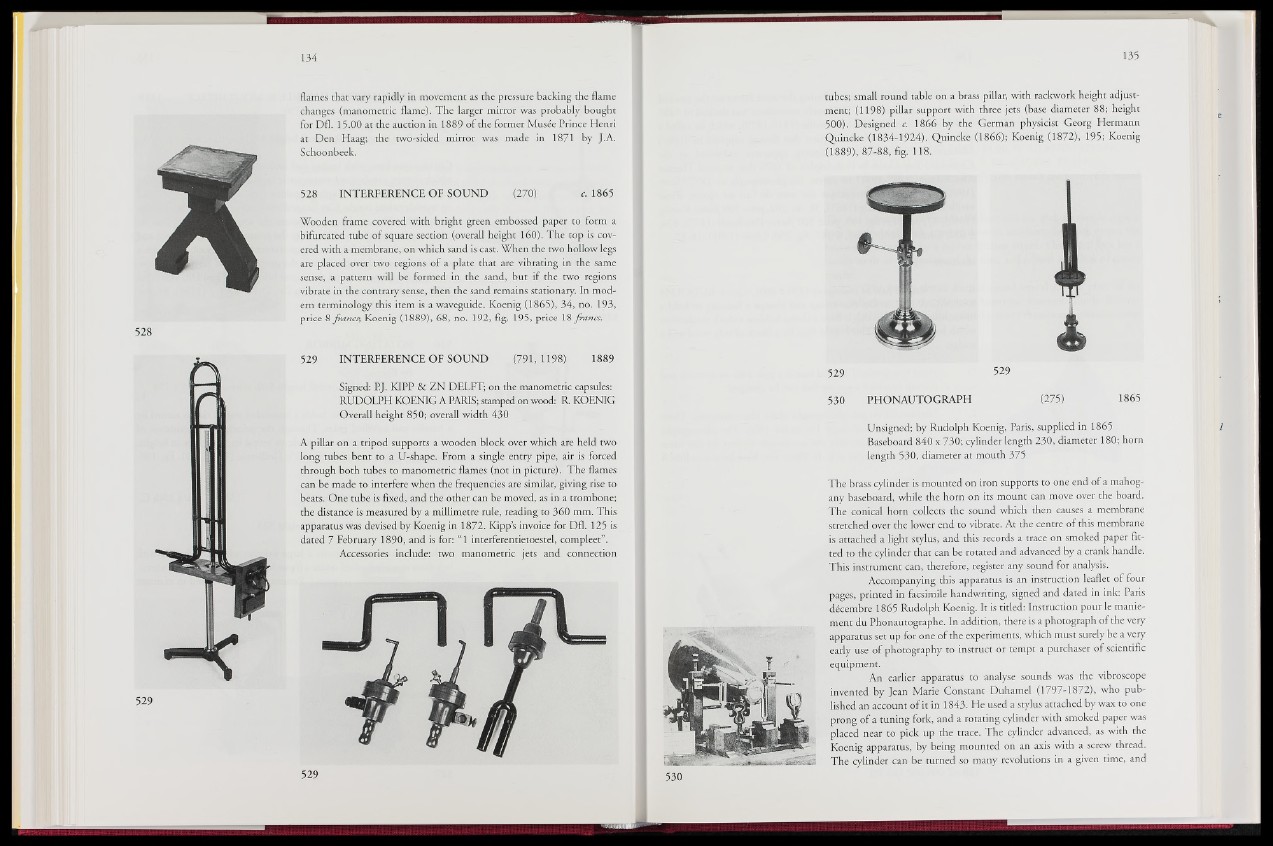
flames that vary rapidly in movement as the pressure backing the flame
changes (manometric flame). The larger mirror was probably bought
for Dfl. 15.00 at the auction in 1889 of the former Musée Prince Henri
at Den Haag; the two-sided mirror was made in 1871 by J.A.
Schoonbeek.
528 INTERFERENCE OF SOUND (2701, . c. 1865
Wooden frame covered with bright green embossed paper to form a
bifurcated tube of square section (overall height 160). The top is covered
with a membrane, on which sand is cast. When the two hollow legs
are placed over two regions of a plate that are vibrating in the same
sense, a pattern will be formed in the sand, but if the two regions
vibrate in the contrary sense, then the sand remains stationary. In modern
terminology this item is a waveguide. Koenig (1865), 34, no. 193,
price 8 francs', Koenig (1889), 68, no. 192, fig. 195, price 18 framsi&i
529 INTERFERENCE OF SOUND Jg 9 1 , 1F98) 1889
Signed: EJ. KIPP & ZN DELFT; on the manometric capsules:
RUDOLPH KOENIG A PARIS; stamped on wood: R KOENIG
Overall height 850; overall width 430
A pillar on a tripod supports a wooden block over which are held two
long tubes bent to a U-shape. From a single entry pipe, air is forced
through both tubes to manometric flames (not in picture). The flames
can be made to interfere when the frequencies are similar, giving rise to
beats. One tube is fixed, and the other can be moved, as in a trombone;
the distance is measured by a millimetre rule, reading to 360 mm. This
apparatus was devised by Koenig in 1872. Kipps invoice for Dfl. 125 is
dated 7 February 1890, and is for: “1 interferentietoestel, compleet”.
Accessories include: two manometric jets and connection
tubes; small round table on a brass pillar, with rackwork height adjustment;
(1198) pillar support with three jets (base diameter 88; height
500). Designed c. 1866 by the German physicist Georg Hermann
Quincke (1834-1924). Quincke (1866); Koenig (1872), 195; Koenig
(1889), 87-88, fig. 118.
529 529
530 PHONAUTOGRAPH (275) 1865
Unsigned; by Rudolph Koenig, Paris, supplied in 1865
Baseboard 840 x 730; cylinder length 230, diameter 180; horn
length 530, diameter at mouth 375
The brass cylinder is mounted on iron supports to one end of a mahogany
baseboard, while the horn on its mount can move over the board.
The conical horn collects the sound which then causes a membrane
stretched over the lower end to vibrate. At the centre of this membrane
is attached a light stylus, and this records a trace on smoked paper fitted
to thé cylinder that can be rotated and advanced by a crank handle.
This instrument can, therefore, register any sound for analysis.
Accompanying this apparatus is an instruction leaflet of four
pages, printed in facsimile handwriting, signed and dated in ink: Paris
décembre 1865 Rudolph Koenig. It is titled: Instruction pour le maniement
du Phonautographe. In addition, there is a photograph of the very
apparatus set up for one of the experiments, which must surely be a very
early use of photography to instruct or tempt a purchaser of scientific
equipment.
An earlier apparatus to analyse sounds was the vibroscope
invented by Jean Marie Constant Duhamel (1797fl872), who published
an aceounijf it in 1843. He used a stylus attached by wax to one
prong of a tuning fork, and a rotating cylinder with smoked paper was
placed near to pick up the trace. The cylinder advanced, as with the
Koenig apparatus, by being mounted on an axis with a screw thread.
The jjflinder can be turned so many revolutions in a given time, and